Looking for Skate vs Stingray comparison? Here you go.
Skates and stingrays can be tough to differentiate. One way to tell them apart is by looking at their tails and fins. Skates have a more triangular or rounded shape than stingrays. Skates have shorter, thicker tails and lack a stinger. In contrast, stingrays have long, thin tails with venomous barbs. Additionally, skates have two lobes on their pelvic fins, while stingrays only have one.
But hold on! That’s just the start of their dissimilarities. Skates and stingrays are worlds apart when it comes to reproduction and behavior.
As cartilaginous fish in the Elasmobranchi subclass, they both love hanging out on the sea floor, where they can find food and stay hidden from predators. However, they are not the same species and have many intriguing differences.
Did you know that skates have thorn-like projections on their backs and tails that provide protection? Meanwhile, stingrays have smooth skin. And when it comes to reproduction, stingrays give birth to live young while skates give birth to eggs in leathery containers known as mermaid’s purses.
Intrigued yet? We’ve only scratched the surface! Keep reading this blog to dive deeper into the fascinating world of skate fish and stingrays. We promise you won’t be disappointed – there’s a whole ocean of discoveries to explore!

Skate Vs Stingray – What Are the Key Differences?
Skates and stingrays are two fish that often get mixed up as they belong to the same class of cartilaginous fish. Both have flat bodies, wing-like pectoral fins, and long tails that help them navigate the water. They also share the same behaviors, like hiding in the sand and flapping their fins to swim.
But don’t get it twisted – there are some clear differences between skate fish and stingrays that will help you tell them apart. Let’s look closer and see who’s who in the undersea zoo!
1. Skate Vs. Stingray: Scientific Classification
Skates and stingrays are both members of the class Chondrichthyes and subclass Elasmobranchii. But they differ in their order and family.
Skate
Skates are in the order Rajiformes, including species with enlarged pectoral fins. Some common species of skates include:
- Flapper Skate (Dipturus intermedia)
- Black Skate (Dipturus nidarosiensis)
- Long-nosed Skate (Dipturus oxyrinchus)
- Blue Skate (Dipturus batis)
- Starry Skate (Amblyraja radiata)
- White Skate (Rostroraja alba)
Stingray
Stingrays are in the order Myliobatiformes. Most species of stingrays belong to the family Dasyatidae, but there are other families as well. Some common species of stingrays include:
- Common Stingray (Dasyatis pastinaca)
- Smooth Stingray (Bathytoshia brevicaudata)
- Southern Stingray (Hypanus americanus)
- Round Stingray (Urobatis halleri)
- Giant Freshwater Stingray (Urogymnus polylepis)
- Pelagic Stingray (Pteroplatytrygon violacea)
- Longnose Stingray (Dasyatis guttata)
- Bluntnose Stingray (Dasyatis say)
| Classification | Skate | Stingray |
| Class | Chondrichthyes | Chondrichthyes |
| Subclass | Elasmobranchii | Elasmobranchii |
| Family | Rajidae | Dasyatidae |
| Order | Rajiformes | Myliobatiformes |
2. Skate Vs. Stingray: Habitat and Distribution
Where Do Skates and Stingrays Live? Skate fish and stingrays are both found in marine waters around the world. But, they have different preferences for depth, temperature, and salinity.
Skates

Skates love to chill in the cold and temperate waters of the Atlantic, Pacific, and Arctic Oceans. They are often found on sandy or muddy bottoms, where they can get buried in the sediment and hide from predators.
You’ll usually find these fish in the shallow coastal waters, where they live on or near the ocean floor. They can handle cold water and low oxygen levels like it’s no big deal. So they can live it up in deep-sea environments too.
Stingrays

Stingrays are found in warmer waters, such as the tropical and subtropical regions of the world. They like to chill in coastal areas, swimming near the surface or along the bottom of the water. They require high salinity levels.
These fish are mostly found in coral reefs, seagrass beds, mangroves, and estuaries. They spend most of their life idle, often lounging around in the sand and just going with the flow of the tide.
| Habitat Type | Skates | Stingrays |
| Water | Cold bottom surfaces | Warmer coastal areas |
| Ocean Floor | ✓ | |
| Coral Reefs | ✓ |
3. Skate Vs. Stingray: Physical Appearance
What makes skate fish and stingrays unique? Skates and stingrays have similar body shapes but different sizes, tails, fins, teeth, colors, and patterns.
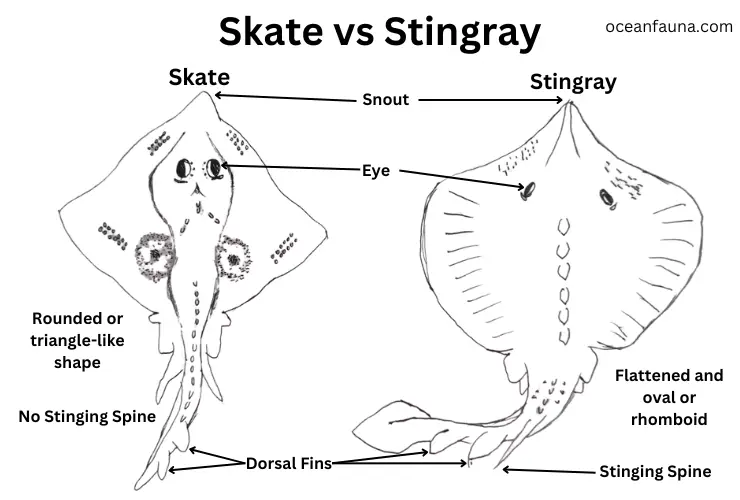
Skate
1. Shape and size: Skates have flattened bodies shaped with a rounded or triangle-like shape. They can be up to 9.5 feet long.
2. Coloration and patterns: They usually have a dull coloration that blends with the seafloor, such as brown, gray, black, or white. Some have spots, stripes, or patches of different colors on their dorsal surface, which may serve as camouflage or warning signals. The ventral surface of skates is usually lighter than the dorsal surface.
3. Fins and tail: They have two pairs of pectoral fins fused to the head and body, forming wing-like appendages. They also have two dorsal fins near the tail and a small anal fin. The tail of the skates is short and thick.
4. Spines: They do not have a stinger. Instead, they have small thorns or spines on their back and tail for defense.
5. Teeth: Skates have small, pointed teeth, which help capture prey.
Stingray
1. Shape and size: Stingrays have a flattened body with a diamond-like or oval shape. They can be up to 16.5 feet long, including the tail.
2. Coloration and patterns: Stingrays usually have a bright or vivid coloration that contrasts with the seafloor, such as blue, green, yellow, orange, or red. Some stingrays have spots, rings, or bars of different colors on their dorsal surface. The ventral surface of stingrays is usually white or pale.
3. Fins and tail: Stingrays have one pair of pectoral fins fused to the head and body, forming a disc-like structure. Their dorsal fin is either absent or so tiny that it is difficult to spot. Some stingrays have long whip-like tails that can be longer than their body, while others have short tails.
4. Stinger: On their tails, they have one or more venomous spines that can inflict painful wounds on predators or humans.
5. Teeth: Stingrays have flat, plate-like teeth that help to crush hard-shelled prey.
Did you know stingrays, like sharks, are always replenishing their teeth? They make new ones at the back and push them ahead as needed – so they never run out of sharp teeth!
| Physical Feature | Skates | Stingrays |
| Body Shape | Flattened | Streamlined |
| Pectoral Fins | Broad with two lobes | Narrow with one lobe |
| Tail | Short and thick | Long and whip-like |
| Spines | None. | Venomous |
| Size | Up to 9.5 feet long | Up to 16.5 feet long |
| Teeth | Small and pointed | Flattened plate-like teeth |
| Dorsal Fin | Small but distinct | Absent or vestigial |
| Color | Typically brown or gray | Varies widely |
4. Skate Vs. Stingray: Reproduction and Lifecycle
How do skates and stingrays reproduce? Skate fish and stingrays have different modes of reproduction.
Skates
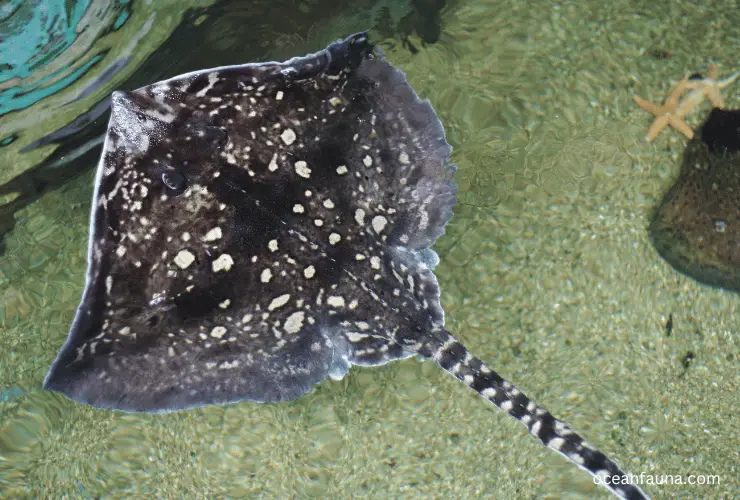
Skates are oviparous. They reproduce by laying eggs. The eggs are enclosed in a tough capsule called a mermaid’s purse. These cases are made of keratin and have four horns or projections, at each corner. The capsule protects the developing embryo from predators and provides oxygen through pores.
The female skate fish deposits the capsule on the sea floor, leaving it to hatch. The incubation period varies depending on the species and water temperature, but it can take around 15 months. The baby skate emerges from the capsule, fully formed and independent.
Stingrays
Stingrays are viviparous. They reproduce by giving birth to young pups. The embryos develop inside the mother’s uterus and receive nourishment from a yolk sac or a placenta-like structure.
They mate between June and July every year. The gestation period can range from a few months to over a year. The female stingray then delivers the pups in shallow water.
The number of offspring varies from one to several dozen. The pups are born with a soft disc and a flexible tail that harden over time. They can be anywhere between 11 and 18 inches. They are independent, ready to swim and feed on their own. Stingrays can live for up to 25 years in the wild.
| Aspect | Skates | Stingrays |
| Mating System | Oviparous | Viviparous |
| Gestation Period | About a year | Around 15 months |
| Lifespan | Up to 50 years | Up to 25 years |
5. Skate Vs. Stingray: Defense Mechanism
Skates and stingrays have different defense mechanisms.
Skates
Skates typically have broad thorn-like scales along the mid of their back or tail, which helps them defend themselves.
Stingrays
Stingrays, on the other hand, have a stinging barb on their tail that serves as their defense mechanism. The stings from their venomous barbs can be deadly for humans.
| Defense Mechanism | Skates | Stingrays |
| Stinging barb | ✓ | |
| Thorn-like Scales | ✓ |
6. Skate Vs. Stingray: Are They Edible?
Both skatefish and stingrays have meat that is edible and safe to consume. But there are some risks to be aware of.

Skatefish can secrete harmful toxins such as ammonia through their skin. If the meat becomes contaminated by this substance, you can become sick. Therefore, if you smell any ammonia around a raw or cooked skate, don’t consume it.
Stingrays’ stingers can secrete poison, so caution should be exercised when handling and preparing them. However, if handled and prepared correctly, a stingray can be a fully edible creature with a texture similar to scallops.
Skatefish is generally preferred in countries like France and Belgium. In contrast, stingrays are popular in countries like Malaysia and Singapore. It is considered a delicacy and is prepared over charcoal with tangy ‘sambal’ sauce or soy sauce.
The most preferred parts of the stingray are the wings, while fishermen generally remove the wings of the skate at sea and ice them down before returning to shore. The flesh of both skate and stingray has a sweet, mild shellfish-like taste because of their same diet.
7. Skate Vs. Stingray: Threats and Conservation Status
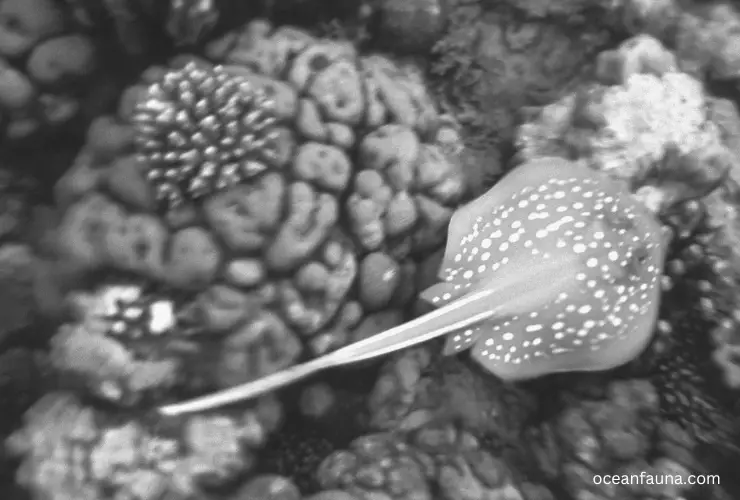
Both skates and stingrays face threats from human activities, such as overfishing, habitat degradation, pollution, and climate change. Some species are endangered or vulnerable, while others are more resilient.
According to the IUCN, there are 283 species of skate fish and 201 species of stingrays worldwide. Of these, a significant population is threatened with extinction. (Source)
Some of the most endangered species include
- Common skate (Dipturus batis), which is critically endangered in Europe and North Africa
- Giant freshwater stingray (Urogymnus polylepis), which is critically endangered in Southeast Asia.
What Do Skates and Stingrays Eat?
Skatefish and stingrays have similar diets and feeding habits. They feed mainly on benthic invertebrates like mollusks, oysters and clams, mussels, and worms. They also eat small fish such as herring, cod, and flatfish.
Both skates and stingrays use their pectoral fins to flap over the sand or mud and uncover hidden prey. They also have modified gill slits to create suction and draw in water and prey. They swallow their food whole or spit out unwanted parts.
Did you know? Both skates and stingrays have a pair of sensory organs called ampullae of Lorenzini on their snouts that help them detect electric fields emitted by their prey.
How Important Are Skatefish and Stingrays to the Ecosystem?
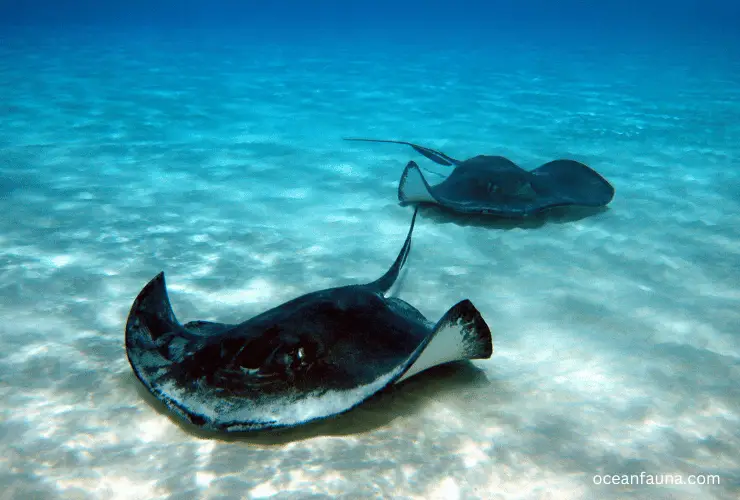
Skates and stingrays play a significant role in the marine ecosystem.
- As cartilaginous fish, they share similarities with sharks and contribute to the food chain balance by being both predators and prey.
- They are also considered “habitat engineers.” These bottom-dwellers dig around in the sand in search of food, creating homes for small invertebrates to live in.
- They are a food source for larger predators like sharks and sea lions.
- They help keep the population of their prey species in check, which helps maintain a balance in the food chain.
- Even after they die, their remains provide a feast for deep-sea scavengers, supporting entire communities of creatures in the ocean depths.
Are Skates and Stingrays Related?
Skatefish and stingrays are closely related but not the same animal. They belong to different orders within the class of Chondrichthyes. Stingrays are in the order Myliobatiformes, while skates are in the order Rajiformes.
Who Hunt Skates and Stingrays?
Skates and stingrays are mainly hunted by sharks, which can attack them from above or below with their powerful jaws. But killer whales, seals, dolphins, and sea lions also find them tasty.
FAQS about Skate Vs Stingray
Q: Is a skate a baby stingray?
A: No, a skate is not a baby stingray. They are different animals that belong to different orders. Skates do not grow into stingrays.
Q: Can a skatefish sting you?
A: No, a skatefish cannot sting you. Skates do not have stingers on their tails like stingrays do. However, they can bite if provoked.
Q: Do skates give live birth?
A: No, skates do not give live birth. They lay eggs in leathery cases called “mermaid’s purses.”
Q: Are stingrays poisonous?
A: Yes, some stingrays are poisonous. Stingrays have one or more venomous barbs on their tails that they use for defense. The venom can cause severe pain, swelling, infection, and even death in humans.
Q: Do stingrays lay eggs or give birth?
A: Stingrays give birth to live young. They carry their offspring inside their bodies until they are fully developed.
Q: What is the name of a baby stingray?
A: A baby stingray is called a pup.
Q: What animal is called a skate?
A: A skate is a type of cartilaginous fish that belongs to the order Rajiformes. Skates have flat bodies and wing-like pectoral fins.
Q: What is skatefish also called?
A: Skate Fish are also called skates.
Conclusion
To sum up, skates and stingrays are a fascinating duo of cartilaginous fish that share some similarities but also have many differences. These magnificent creatures have adapted to two different environments and lifestyles.
Skate fish are often found in colder and temperate waters, while stingrays live in warmer and tropical waters. Despite these differences, both skates and stingrays are equally captivating in their own ways.
Their unique similarities and differences make them like the ultimate game of spot-the-difference! We hope our blog post has satisfied you with all the fascinating information you’ve soaked up!

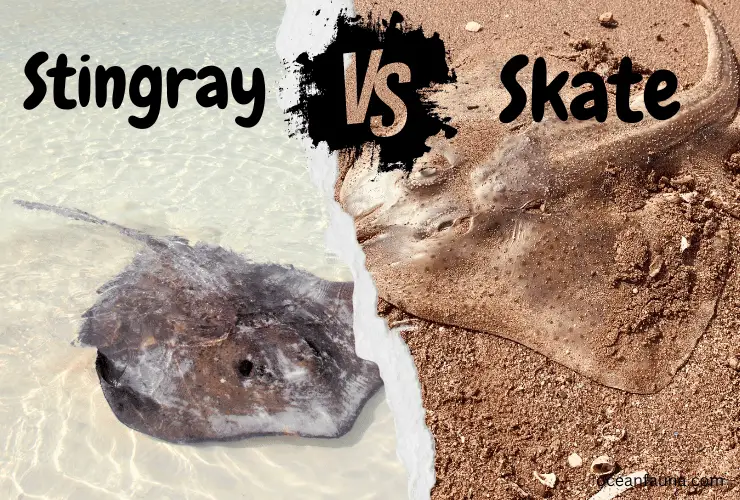
1 thought on “Skate Vs Stingray: Differences and Similarities Explained”